World War 2
ARP Wardens
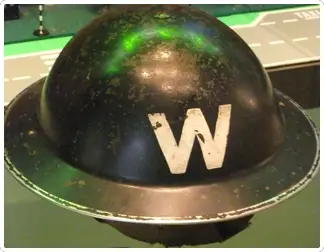
ARP warden’s helmet.
The ARP wardens were everywhere in Britain in World War Two. In 1937, 300,000 civilians signed up to be trained as Air Raid Patrol (ARP) wardens. By the end of the war, 1.4 million men and women served in this job. There was supposed to be a warden for every street. It was important for the wardens to be local so that they knew the neighbourhood and the people who lived there.
There were both full and part-time ARP wardens. The full-time wardens were paid a salary, but most did their job as volunteers, as well as working a job during the day. They took their jobs seriously as a way to help the war effort and serve their country. Many of the men were veterans of World War One. One-sixth were women.
At first, they did not have a full uniform. They wore their own clothes with an armband, Wellington boots, and a steel helmet with a W on the front. The chief ARP warden had a white helmet with a black W, while the others had black helmets with white Ws. In 1941 they got blue serge uniforms to wear when on duty. They also carried a police whistle, torch, first aid kit in a haversack, and their gas mask.
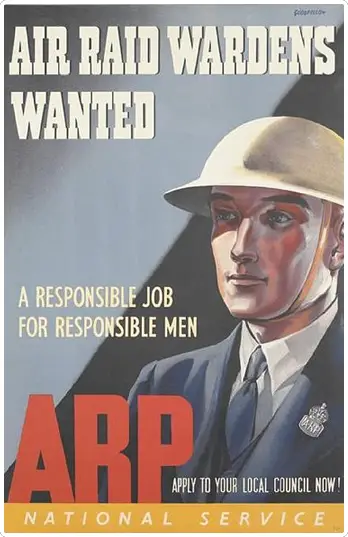
Recruitment poster for Air Raid Wardens
Part of their job was to make sure that everyone in Britain was following the rules to keep everything on the ground hidden from German bombers at night, so that they would not be able to see their targets. The nightly blackout was imposed on September 1 1939, with the wardens posting daily the start and end times that everyone had to follow. They would patrol at night, and report any houses that had even a crack of light showing. The householders could be taken to court and fined. Everyone dreaded being caught by the warden with light shining out into the dark.
ARP posts were set up on street corners across the country, so that people would be able to easily find a warden when they needed one. Unfortunately, during the Phoney War in the winter of 1939/40, they started to be called the “darts brigade” because with nothing to do, they could be seen playing darts in their posts. Between that and the wardens being strict about the blackout, some people started to resent them.
When the Blitz started in September 1940, however, they had plenty to keep them busy, and people changed their feelings as they saw how hard and bravely the wardens worked. During an air raid, the wardens sounded the sirens telling people that a raid was coming. They made sure that people made it safely to their shelters and then patrolled the streets. They would watch for incendiary bombs starting fires, and call for aid from the firefighters, and help with fighting the fire themselves. If people were injured, the wardens would help tend them until they could be taken to the hospital. They also helped to remove people from the rubble of bombed buildings.
After the air raid ended, it was their job to locate any unexploded bombs and keep people away until the army’s bomb disposal team arrived to deal with it. They had to evacuate all buildings and streets within 600 yards of the bomb.
The ARP wardens also were supposed to make sure people were following the rules for their gas masks. Everyone was supposed to carry theirs at all times, although not many did as time went on. The wardens had to make monthly inspections to make sure that everyone still had their gas mask, or pay for a replacement. Wardens had special masks with a long hose and a speaking box on their belts, since they would have to be able to talk with the public during a gas emergency.The wardens would shake a hand rattle if a gas attack was underway, and then ring a hand bell when it was safe to remove the masks. Luckily, there never was a gas attack.
Wardens also acted as community organizers and tried to keep up the public’s spirits. They organized concerts and played cricket matches to keep people entertained. They held parties for children, with whatever treats they could find in the days of rationing, entertaining the children with Punch and Judy shows, magicians, and visits from Father Christmas.
Throughout the war the ARP wardens played an important part in keeping people safe.
ARP Duties during world war II
 Blackout Observers
Blackout Observers Report & Control
Report & Control Messengers
Messengers First Aid Parties
First Aid Parties Ambulance drivers
Ambulance drivers Rescue services
Rescue services Gas decontamination
Gas decontamination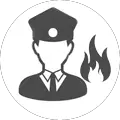 Fire Guards
Fire Guards
Blackout
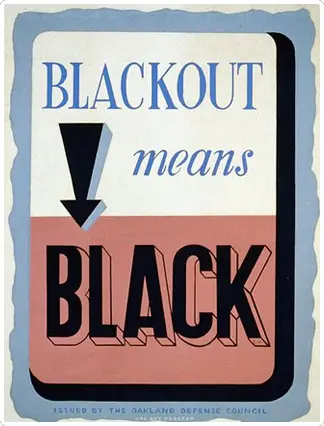
Long before war was declared on September 3 1939, the British government started preparing for an attack from the air. There had been a limited blackout in World War One, but everyone knew that much of the next war would be fought in the air, and they needed to be prepared. Germany had their first blackout rehearsal in 1935.
In 1937, 300,000 civilians signed up to be trained as Air Raid Patrol (ARP) wardens. Their first job was to make sure that everyone in Britain was following the rules to keep everything on the ground hidden from German bombers at night, so that they would not be able to see their targets. The British practised the blackouts starting in early 1938, with RAF planes flying overhead to see what needed to be improved. The nightly blackout was imposed on September 1 1939, with the wardens posting daily the start and end times that everyone had to follow.
Every house in Great Britain had to have blackout curtains that completely covered every window. They had to be sewn out of black, dark green, blue or brown fabric, and could not let through any light. They had to be sealed to the window frames so not even a crack of light showed through. The curtains could not be washed, as that might weaken the fabric and let light leak out. Sometimes it took as many as three layers of fabric to completely hide the light. ARP wardens would patrol at night, and report any houses that had even a crack of light showing. The householders would be taken to court and fined.
At first cars were not allowed to drive with their headlamps on. This caused many accidents and deaths. In September 1939 alone, 1130 people died, either while driving or being hit by a car while they walked in the dark. Pedestrians were advised to carry or wear something white to make them more visible, and white stripes were painted along roadsides. By 1940 the speed limit was reduced to 20 mph, and cars were allowed to use their headlamps if they covered them with a mask that left only 3 small slits of light. Even with these changes, driving at night was still very dangerous.
People couldn’t even walk safely at night without lights, and at the beginning there were very strict rules for pedestrians. Even a lit cigarette was not permitted, and when one man struck a match to find his false teeth, he was fined 10 shillings. As well as the danger from cars, without any light to see where they were going some people walked off bridges and drowned, or fell from railway platforms. They were later allowed to use torches, as long as the light was covered with tissue paper and aimed towards the ground, but most people couldn’t get the batteries needed to power them anyway.
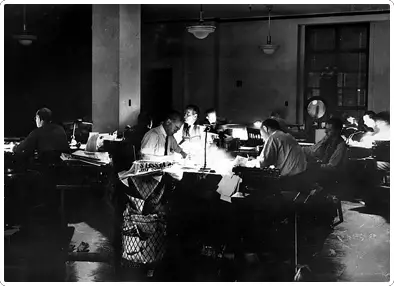
Blackout restrictions created problems for factories, too. Many factories had glass roofs, which had to be completely painted over, and since the factories were running all night to produce goods for the war effort, they had to be lit at night and still let no light show from above, especially since factories producing weapons, planes, tanks, or other military essentials would have been prime targets for the German bombers. Factory workers on the day shift might not see the sun at all, except on their rare days off. Many workers got very depressed as a result.
Shopkeepers, pubs, and cinemas had to find a way to let their customers enter and leave their businesses without letting any light escape. They had to set up special hallways or dividers which took up extra space and made it difficult for people to move around easily. Often, people just decided to stay home where it was safer than on the darkened streets.
By September 1944, as the Germans were pushed back out of France and their bombers could not as easily reach Britain, the rules were changed, and the blackout became the “dim-out.” Lights as bright as moonlight could be used, unless there was an air raid alert, when there would have to be a full blackout.
The blackout ended on April 23 1945. On April 30, Big Ben was lit up for the first time since September 1 1939.
Effect of Children
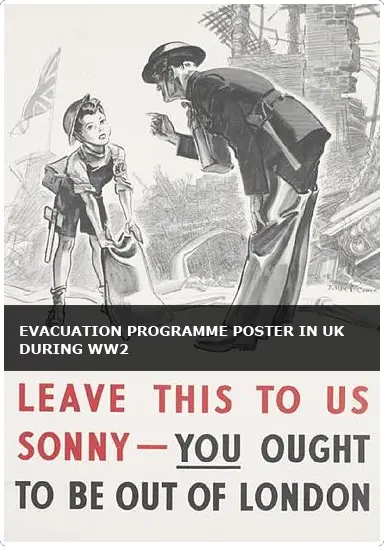
Living in Great Britain during World War Two was a very difficult time to be a child. Their ordinary lives were disrupted by the dangers of the war and the restrictions on their activities. Many lost their fathers, or did not see them again until the war was over.
Thousands of children were evacuated to the countryside when the cities were bombed by the Germans in 1940 and 1941. They were separated from their parents at a very young age, and found themselves living with strangers in remote parts of the country. Some children were lucky and were billeted in good homes with caring people, while others had less happy experiences. After the Blitz ended most returned home to their parents, but they were still at risk, especially in 1944 when the Germans launched the V1 and V2 rockets against London.
Their education was affected by the war as well. Most of the younger male teachers signed up or were called up to the military, so older retired teachers had to go back into the classroom. Children were put into larger classes with fewer supplies such as books, and their learning suffered as a result. Many schools also closed, at least temporarily, because of the bombings in the cities. Classes were held in pubs, churches, and outside in good weather.
Some children were left with no one to look after them for much of the time, while schools were closed and their mothers were working in factories and their fathers were away at war. Daycares were set up for the younger children while their mothers were at work.
Children were encouraged to play their part in the war effort. One of the ways they could do that was by collecting items such as metal, paper, and rags to be recycled and used in making war supplies. They would gather up things like old bicycles, pots and pans, and toy cars for use in making tanks, airplanes, and ships. When the BBC Children’s Hourran a competition, the winning crew collected 9 tons of scrap metal.
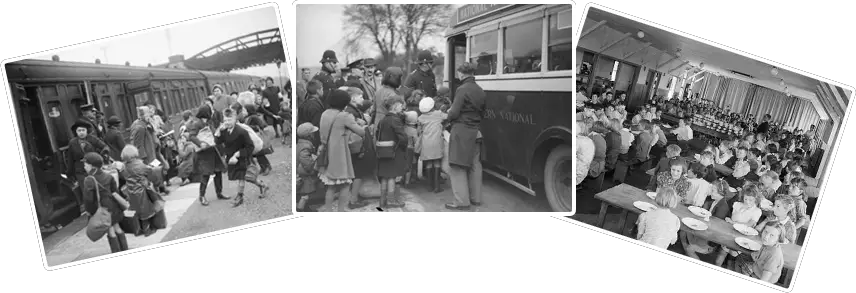
If a child collected enough, they could get a red Junior Salvage Steward cog badge, which gave them a sense of accomplishment and that they had made a real contribution to the war effort. They even had their own song, “There’ll Always be a Dustbin”, using the music from “there’ll Always be an England.”
Younger children also knitted items such as hats for the soldiers, and helped with fund-raising for the war effort. They also would have helped their families grow their own vegetables to improve their diets and reduce the demand for crops at a time when most of the able-bodied farm workers were serving in the military.
During air raids, Boy Scouts from the age of 14 up took on some very important tasks. They were firefighters, using the heavy hoses to put out fires. They also served as fire-watchers, going up to high towers to spot new fires as they started. Boy Scouts acted as messengers, crossing the cities, despite the danger of being out in an air raid or blackout, to deliver the news to the relatives of people seriously injured in the air raids. They worked as stretcher-bearers at hospitals, being given the responsibility of deciding how serious an injury was and how quickly a doctor was needed.
Girl Guides as well had an important role to play. They took on a leadership role in air raid shelters, keeping the children entertained and spirits up. Some even worked on fire-fighting crews. They worked as volunteers in hospitals, using their first aid skills to help with injured people. They also collected sphagnum moss to use as wound dressings, and played a big role in scrap drives for goods to be recycled. Their enthusiasm for fund-raising resulted in £50,000 being raised in one week at a bazaar. That money bought a lifeboat that saved the lives of soldiers stranded on the beaches at Dunkirk in June 1940.
Even younger Brownies had important contributions to make. In 1941, Brownies were given the job of collecting empty thread reels for the RAF. They got 15,000, which were used to smuggle maps, microfilm, and German money into occupied countries and help with the resistance movements there.
Both Boy Scouts and Girl Guides received training and learned skills that would make them valuable members of the armed forces. A child of 12 in 1939 when the war started would have been able to join up or be called up before the end of the war, and they were more valuable to the military because of their experience.
Evacuation
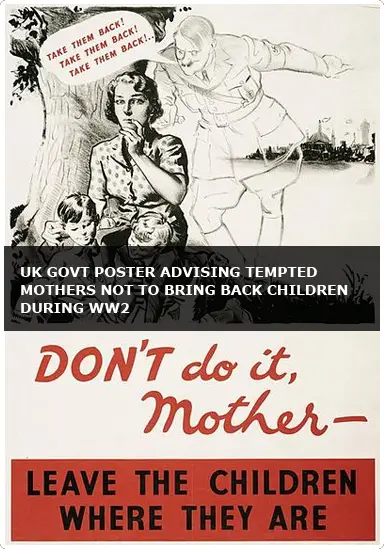
In 4 days at the beginning of September 1939, almost 3 million people, mostly children, were moved from the cities to the countryside of Great Britain.Even before the war started, there were fears that British cities would be bombed by the Germans. The government wanted to remove children from the cities to protect them from being injured or killed, and the plans had been ready for more than a year. It was called “Operation Pied Piper.”
Children were organized into groups in the cities, with a label attached to each like a piece of luggage to identify them. Their teachers or volunteers led the children to the railways or buses that took them out of the city to pre-arranged destinations in the country. Their parents stayed behind in the cities, saying goodbye to their children, sometimes as young as 5. Mothers went along with children under that age. Many pregnant women and disabled person left as well. 100,000 teachers and other volunteers also went to the country to help with the sudden influx of children.
Each child was supposed to bring some essential supplies:
 Clothes: underwear, night clothes, slippers, socks, winter coat
Clothes: underwear, night clothes, slippers, socks, winter coat Toiletries: toothbrush, comb, towel, washcloth, soap, handkerchiefs
Toiletries: toothbrush, comb, towel, washcloth, soap, handkerchiefs Gas Mask
Gas Mask
When the group of children arrived in the safe location in the country, they were divided up among the host families, who chose the children they wanted. Often brothers and sisters were split up against their wishes. The host families got 8 shillings a week per child to help with the expenses.
After the first evacuation in September 1939, nothing seemed to be happening in the war. It was called “The Phony War” because there was no fighting, and the cities of Great Britain were not being bombed. Against the government’s advice, many children returned to their parents in the cities, but when the Blitz started in September 1940, most went back to the countryside.
Some children had a good time in their new homes. City children who had never been to the country learned a whole new way of life, surrounded by nature and farms. For very poor children from the inner cities, they had a better diet in the country, even with rationing. Many children formed close bonds with their host families. Some even ended up being closer to the new family than their own parents, and were adopted. Others kept in close touch with their new friends for the rest of their lives.

Other children had very bad experiences. Some were forced to work as unpaid labourers on farms or in small businesses for their host families. Others were beaten or underfed. As well, some poor children were looked down on or accused of being dirty or carrying diseases or lice into their new homes. Being separated from the families they loved was enough of a burden for some, even if they were treated well by their hosts.
Not all evacuees were sent to the British countryside. By 1940, over 13,000 children were sent abroad to family or friends in Commonwealth countries such as Canada or Australia, or to the United States. In June 1940 the British government set up the Children’s Overseas Reception Board (CORB), and after 2 weeks they cut off applications when they received 211,448 requests from parents. On July 21 the first ship left Liverpool with 82 children headed for Canada. The North Atlantic was a dangerous place during the war, with German U-boats prowling in wolf-packs for Allied ships. Sadly, on September 17 1940, the City of Benares was sunk by a torpedo from a U-Boat, and 84 children died, along with 171 other passengers. That ended the CORB. Only 3,127 children were evacuated in that program. While many returned home at the end of the war, others settled in their new countries, sometimes with their parents who travelled out to join them.
Some children returned to their homes at the end of the Blitz in the spring of 1941, although many again were sent to the country when the V1 and V2 attacks started in June 1944. Others, happy in the countryside, stayed with their host families until the war was over. Some never left, or returned later after the war to a life they had grown to love outside the cities.
The evacuation must have saved many lives. Only 5000 of the 60,000 British civilians killed in World War Two were children.
Gas Masks
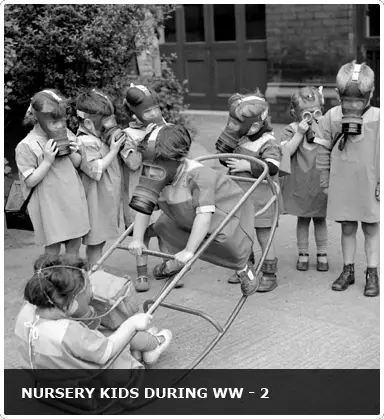
Poison gas had first been used in World War One, mostly by the Germans. Mustard, chlorine and phosgene gas attacks had killed many Allied soldiers and left many more with permanently injured lungs.
By the late 1930’s, the British government was sure that the Germans would try to use gas to kill civilians in Britain. Especially after gas was used by the Italians when they invaded Ethiopia in 1935/6, military planners looked at what would happen if gas bombs were dropped on British cities. They thought that 250,000 people could be killed in just the first week of the war. They decided that it would be best to supply each and every person in Great Britain with their own gas mask in case of a gas attack.
By the end of September 1939, 38 million gas masks had been handed out. Each mask came in a cardboard box with a string to go around the neck, and everyone was required to carry it with them wherever they went. However, by the start of 1940, many people did not bother to carry them, finding them a nuisance, even though department stores sold more attractive bags to carry the gas masks in. ARP wardens were expected to make monthly inspections to make sure that everyone still had their gas mask, or pay for a replacement. There were many gas masks left in railway lost property offices.
Even babies were issued gas masks. They were very different from adult ones, though. They covered the baby’s whole torso, with a hand pump to pump in air. There was a large visor on the front of a steel helmet for the baby to look through. When parents practised putting their babies in the masks, it appears that they didn’t get enough air because they seemed to fall asleep very quickly. There were also gas-proof prams for babies.
Children between the ages of 2 and 4 were given what were called Mickey Mouse gas masks. They didn’t actually look like the Disney character, but were made of bright red and blue rubber to appear less scary to little children. Parents were encouraged to make practising to wear the gas mask a game, so that little children would want to wear them. Children soon learned that they could make a raspberry noise while breathing out through the rubber flap, which certainly made it more fun for them.
Adult gas masks were made of black rubber. ARP wardens had special ones with a long hose and a speaking box on their belts, since they would have to be able to talk with the public during a gas emergency.

The instructions for children and adults were
the same:
1. Hold your breath.
2. Hold mask in front of face, thumbs inside straps.
3. Thrust chin well forward into the mask. Pull straps as far over head as they will go.
4. Run finger round face-piece taking care head-straps are not twisted.
They had to practise putting on the mask so that in a case of a real emergency they would be able to do it quickly enough to protect them from the gas. As well, they were supposed to put up their collars, put on gloves or keep their hands in their pockets, put up their umbrella, and head into the nearest building. The ARP wardens would shake a hand rattle if a gas attack was underway, and then ring a hand bell when it was safe to remove the masks.
The government wanted to know what gas had been released in the case of an attack so they could get rid of the danger as soon as possible. They formed neighbourhood Gas Identification Squads, and painted the tops of Post Office pillar boxes with paint that could detect gases. They also sent out leaflets that described the effect that different gases would have.
In the end, all the preparation was for nothing. There were no gas attacks during the war. The British had been prepared as well to use gas against the Germans, if necessary. In 1941 Winston Churchill complained that the production of phosgene gas-filled shells was falling behind. The British never used gas either, however.
Identity Cards

When the war started, the government knew that they would have to keep track of the population so that they could make better plans to help win the war. The government would need to know who was available to work in wartime industries and in agriculture, especially since so many men were signing up to fight. They would also need to know which men were available to be called up to fight.
As well, with so many people, especially children, being moved out of the cities, it was important to keep track of them. And since rationing was likely to be introduced, the government had to have good records of who lived where, and how many people there were. The last census had been in 1931, and the population had changed since then.
The National Registration Act was passed in the first week of September 1939. On September 29, every person in Great Britain was to be registered on forms delivered to each house. An enumerator went to each household and gave each resident a brown identity card, based on the information on the forms. Those cards remained in effect until 1952, when the government abolished the cards.
Each person’s identity card had the following information:
- National registration number
- name
- gender
- age
- Occupation
- Address
- Marital Status
- Membership in any British military force such as Naval, Army, or Air Force Reserves, or Civil defence Services or Reserves
Every person in Britain was required to have a card, including babies. Many mothers had not registered their sons in 1939, as they did not want them called up to fight, but when rationing was introduced in January 1940 they needed food to feed them, and without being registered they could not get a ration book, so they were then registered.
Parents were told to keep the cards of any child under the age of 16. Starting in 1943, adults were issued new cards that were blue, while the children’s cards were still brown. If a person’s address changed, the registration office had to be informed, and the card would be stamped to indicate that the change was correct.
People had to carry their identity cards with them at all times. They could be ordered to produce it at any time to prove that they were not German spies. The police and armed forces members, and Home Guardall had the right to ask to see a person’s card at any time. People also had to use their identity cards when using their ration books and clothing coupons in shops, to make sure that they weren’t getting someone else’s rations.
The identity cards were very useful during the Blitz. The cards could be used to identify dead or injured people, and helped reunite families that got split up during the air raids. They also helped keep track of evacuated children so that they could be returned to their families when it was safe to do so. As well, the registry made it easy for the government to identify young men of the right age to be called up.
After the war, the same registry was used to set up the National Health Service, and the information collected back in 1939 is an important source of information about the population, since the 1931 census records were destroyed in a fire in 1942, and another census was not taken until 1951.
Rationing

The government was pretty sure from the beginning of the war that they would have to start rationing. They had done it in World War One, as well. During wartime, it was more dangerous for ships to cross the Atlantic with food from Canada and the United States. The German Uboats were sinking as many ships as they could to prevent the British from getting the supplies they needed to fight the war. Also, British farmers had trouble producing as much food when all the young men joined the armed forces. If everyone was going to be able to get the essential food that they needed, the government would have to control the supply.
Rationing started on January 8 1940. Every person in the country, including the members of the Royal Family, was given a ration book, based on the registration done in September 1939. The first goods to be rationed were bacon, butter, and sugar, with meat, cheese, fresh eggs, jam, tea, cereals and milk added by the end of 1941.
A ration book could only be used by the person named on it. People had to show their identity card to prove who they were. Everyone had to register with a grocer and butcher, and then the shopkeeper was given just enough food for the people on the list. When a woman went in to pick up her rations for her family, she would hand over her family’s ration books, and the shopkeeper would take out the coupons for that week, and give her exactly what she was allowed. The coupons were sent to the Ministry of Food so they would know how much to deliver to that shop the next week. The ministry also told the shops how much they could charge for everything.
The quantities of rationed goods were very low. Everyone got 1 egg a week, and only 4 rashers of bacon. They were allowed 2 oz each of butter and tea, and 8 oz of sugar. Families would pool their coupons to buy things such as tinned goods and jam.
Sweets were still available, but only 4 oz a week per person. They were usually bought at the newsagent or a sweet shop, and were the only treat that children could look forward to all week. Rationing of sweets continued until 1953. When the government tried to end it in 1949, after 4 months they had to ration them again because of the high demand.
Some people got more food than others because of their special needs. Pregnant women and children under 5 got a free pint of milk a week, and an extra egg.Children also got an extra ration of orange juice. If orange juice was not available, it was recommended that they get blackcurrant or rosehip syrup to make sure that they got enough Vitamin C. Even raw turnip was suggested as a source of Vitamin C. The Ministry of Food urged parents to make sure that the children’s rations were not eaten by the adults in the household, so that their growing bodies would be healthy. Some parents registered their children as vegetarians so that they would get extra cheese allowances, which then could be shared amongst the family, while the children still got some of their parent’s meat allowance.
One way that families coped with rationing was by growing as much of their own food as possible. People turned their gardens into vegetable plots, and raised their own pigs and rabbits for meat, and chickens for eggs and meat.
It was not just food that was rationed. Petrol was necessary for fighting the war and had to be imported from overseas, so the supply for civilians was very limited. Clothing could only be bought with coupons as well, so people learned to make do with what they had. They would mend a dress rather than buy a new one.
There were still people who tried to cheat the system and buy extra food on what was called the black market. If people had the money, they could find what they wanted, but if they were caught, they and the seller would be punished. When some hotels bought 150,000 eggs on the black market in 1941, the dealer got sentenced to 3 months hard labour, and the hotels were fined.
Rationing in Britain did not end completely until 1954, 9 years after the end of the war, as the effects of the war lasted that long on the British economy and Europe in general.
Shelters

Even before 1939 when the war started, the government was preparing for a war that would be fought from the air. In World War One German zeppelins had bombed Britain, and they could see that Hitler was building a huge air force, called the Luftwaffe, which would be able to attack British cities. Air shelters were being built before war was declared.
3 million Anderson shelters were built in back gardens across the country. The design was cheap, simple, and strong, and the parts could be easily manufactured and then put together by the householder. Poorer families were given the shelters for free, while people with more money had to pay a small fee.
It was made of corrugated metal, 6 feet tall, 6.5 feet long, and 4.5 feet wide.
The shelters were dug 4 feet down into the ground, with earth covering the roof. People would plant gardens over top of them, especially vegetables to supplement their rations. There were also competitions for the best-decorated shelters.
Its purpose was to provide a safe place for the family to sleep during a night air raid. Space in the shelters was tight for a family of 6. There were two levels for sleeping. During the height of the Blitz, they were used every night. They provided some safety, but they were damp and cold, especially in the winter, and flooded easily.
Morrison shelters were built inside houses, on the ground floor. They had the advantage of being warmer and drier than Anderson shelters. Since most British houses did not have cellars to hide in, the people needed something that could survive a house collapsing around it. The Morrison shelter was a cage, table-height, which was put together out of 359 parts with 3 tools. Inside the cage was room for two people to sleep fairly comfortably, although often there were some children in there as well. 600,000 were distributed by 1943.
Not everyone could shelter safely at home, such as any one who lived in a flat. Public air raid shelters were built to provide a safe refuge for those people. Surface ones were built but didn’t provide very good protection from a direct hit from a bomb, and they tended to be overcrowded with poor ventilation. In 1940, the government started building deep shelters, 180 steps down a winding stair, where thousands of people could safely wait out an air raid. They had bunk beds, washrooms, medical facilities, and a canteen. One shelter alone, at Clapham South, could hold 8000 people.
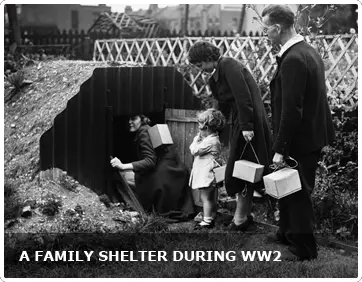
Not all air raids were at night, and schools had shelters as well if the sirens sounded during the school day. Some were located outside the building, buried in the ground. Students would file out of the building with their teacher and go to their assigned shelter, staying there until the all-clear sounded. Other schools had basements where they could wait out the attack. Sometimes classrooms were converted into bomb shelters with reinforced concrete blast walls and ceilings. Teachers would try to carry on with lessons during the raids.
The Underground stations were a popular place for Londoners to use as shelters. People would line up all day to get their spot on the platforms when they were allowed in at 4 pm. While at first the government did not want to let people spend the night in the stations, they gave in to the popular demand, and the stations were full every night. They weren’t always safe from bombs, though. Hundreds of people died when bombs hit stations that were too close to the surface.
Some people just got out of the city altogether every night. Trains ran to Chislehurst in Kent, where there were 22 miles of tunnels in an old chalk mine, 100 feet below ground. Starting in 1939, local people turned it into a shelter, with air piped in, electricity, and latrines. Thousands of people from east London stayed there during the Blitz, either because their homes had been destroyed, or to keep themselves safe from the bombs.
The caves opened for the night at 7 pm. People paid sixpence a week for adults and half that for children. They could keep the same spot if they were regulars. Music had to stop at 9 pm, and everyone was supposed to be inside for the night at 9:30. The caves easily held 15,000 people. There was a cinema, hospital, barber, and three canteens, and a chapel. The caves remained open until 1945.
Shelters did not keep everyone safe during the Luftwaffe air raids of World War Two. However, the combination of all of the different shelters saved many lives that would otherwise have been lost.
The Blitz

On September 7, 1940, the German air force (the Luftwaffe) started a new phase of the war when they started dropping bombs on London. For the two months before that, Hitler had been planning an invasion of Britain. To prepare for it, he had ordered the Luftwaffe to destroy the Royal Air Force (RAF) so that the British defenses would not be able to stop the invasion. In July and August, the Luftwaffe bombers had concentrated on destroying air bases and other targets of military importance.
However, by the beginning of September, Hitler had decided against an actual invasion. Instead, he wanted to force the British to surrender by attacking the civilian population, so that they would insist on the government negotiating a peace treaty with Germany. The cities became the main targets for German bombs.
Starting at 4 pm on September 7, 348 bombers and 617 fighters attacked London from the air, with a second wave two hours later. The main target was the docklands in East London. The bombing lasted until 4:30 am the next morning. 450 people were killed and 1300 injured on that night alone.
For the next 57 days in a row, London was bombed. In the first 30 days, 6000 people were killed and more than 10,000 injured. Most important buildings in London were hit, including Buckingham Palace, the Houses of Parliament, and St. Paul’s Cathedral. One-third of London’s buildings were destroyed, either by being bombed, or in the fires caused by the bombs. By the end of October 1940, 250,000 Londoners had lost their homes.
Other cities were attacked, too. On November 14/15 1940, the Luftwaffe dropped 503 tonnes of bombs and 900 fire bombs on Coventry. 568 people died and 850 were injured. One-third of the city was damaged or destroyed, including its medieval cathedral. Liverpool, Bristol, Portsmouth, Manchester and other important port cities and manufacturing centres were bombed many times.
The German bombings had a huge impact on ordinary people. Every night, their homes and lives were at risk, and they got used to a new routine when the bombers were heard overhead and the air raid sirens went off.
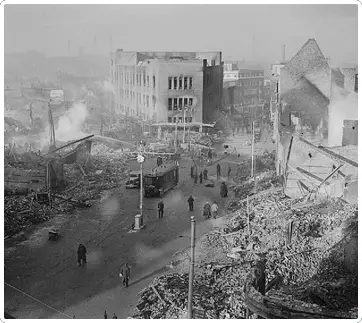
People who had back gardens often built Anderson shelters, made of corrugated steel covered by 3 or 4 feet of earth, for their family to go to when an attack was coming. 3 million of them were built across the country. There were also town bomb shelters. The raids were so frequent that many didn’t even bother trying to sleep at home and spent every night in the shelters.
In London, the Underground stations were often far below the surface and were the one of the safest places to be during a bombing raid. Although at first the government didn’t like the idea, soon thousands of Londoners were spending their nights sleeping on the Underground platforms.
Hitler had planned the Blitz to break the British spirit and make the ordinary people want to end the war as soon as possible, but it didn’t work that way. The British got mad at the Germans for killing their people and destroying their cities, and made them more eager to defeat Hitler rather than sign a peace treaty with him.
Another effect of the Blitz was that it brought the people together because they shared the experience of being bombed, and living in the shelters. Even the Royal family became a part of the experience. After Buckingham Palace was bombed on September 13, George VI’s wife Queen Elizabeth said, “I am glad we have been bombed. It makes me feel I can look the East End in the face.”
During the entire period of the Blitz in 1940/41, more than 40,000 civilians died, and rebuilding after the damage done to the cities by the bombs and fires was not completed until many years after the war ended.
The Blitz continued throughout the winter and into the spring of 1940/41. On May 10 1941, a major attack killed 3000 people and hit the Tower of London and Westminster Abbey. However, the attacks mostly stopped in May, since Hitler was moving his forces to the Eastern front ahead of his invasion of the Soviet Union in June.
The Blitz

In the spring of 1940, as the British watched the countries of Europe fall one after the other to the oncoming German army, there was a very real fear that Britain would be the next country to be invaded and defeated by Hitler’s army. There was a need for a force based in Britain to defend in case the Germans attacked. So, on May 14 1940, the Minster of War, Anthony Eden, announced on the radio that: “We want large numbers of men in Great Britain who are British subjects between the ages of 17 and 65 to come forward now and offer their assistance.”
Eden and the government expected 150,000 men to volunteer in total. They got 250,000 within 24 hours, and 1.5 million by August. They weren’t ready for that many volunteers. Men who were rejected for medical reasons to serve in the regular armed forces were eager to do their bit. Men who were over the age of 45 were still ready and willing to defend the country. Many of them were veterans of World War One and had valuable combat experience that would be helpful.Many of them were young men, however. One-third of them were under 18 when they signed up.It was a useful way for the younger members to get some military training before being called up to the Army.
In May the new force was called the Local Defence Volunteers. By August, Prime Minister Winston Churchill changed the name to the Home Guard. The Home Guard were a part-time army; they worked during the day and trained at night. Training for the Home Guard was made difficult by the lack of uniforms and weapons. The War office wasn’t prepared for the numbers who enlisted and didn’t have the supplies ready. Only one-third of the Home Guard had rifles. The others practiced with shotguns, hunting guns, or even golf clubs and pitchforks. Eventually they got World War One rifles sent over from Canada and the United States.
The Home Guard were trained to deal with Germans invading Britain. They practised catching German paratroopers, fighting in the streets against the enemy, and were trained to use explosives. They removed road signs so that Germans would not be able to move around easily. They were taught simple German phrases like “Hands up!”, “Put that revolver down.”, and “Turn around and keep walking”. Their job in the case of an invasion would have been to keep the Germans busy until the regular army could establish its front line. Thousands of volunteers were trained in guerilla fighting methods at a special school run by a veteran of the Spanish Civil War. He wanted the men to be prepared to fight the Germans from hidden positions if there was an invasion.
Even without an invasion, the Home Guard was very useful. They patrolled waterways and seacoasts to prevent Germans from coming ashore in secret. They manned anti-aircraft guns during the Blitz, and helped rescue people trapped in bombed buildings. They stood guard over damaged banks and shops to prevent looting. They were able to keep an eye out in their local area for strangers who might be German spies, and checked people’s identity cards. If they didn’t have their cards, they might be handed over to the police. The Home Guard did all of this work in addition to their paying jobs. They were not paid for their Home Guard duties.
When it was clear that the Germans were not going to invade, the Home Guard wasn’t seen as important to the war effort. A lot of members started to skip their assigned duties by 1943, and although the Home Guard continued to man anti-aircraft guns along the coast against the V1 rockets into 1944, in December 1944 the Home Guard was disbanded after a parade in front of King George VI, who praised them for their contributions to the war effort. Winston Churchill let them keep their boots and uniforms.
1206 members of the Home Guard died in the line of duty, and 557 others were seriously injured. There had been 1,793,000 men serving in the Home Guard.
Home Guard Honours
- Ribbon
- Medal
- Ribbon /
- Medal
-

George Cross (GC)
-

Officer of the Order of the British Empire (OBE)
-

George Medal (GM)
-

British Empire Medal (BEM)
-

British Empire Medal (BEM)
-

Military Medal (MM)
-

Defence Medal (United Kingdom)

